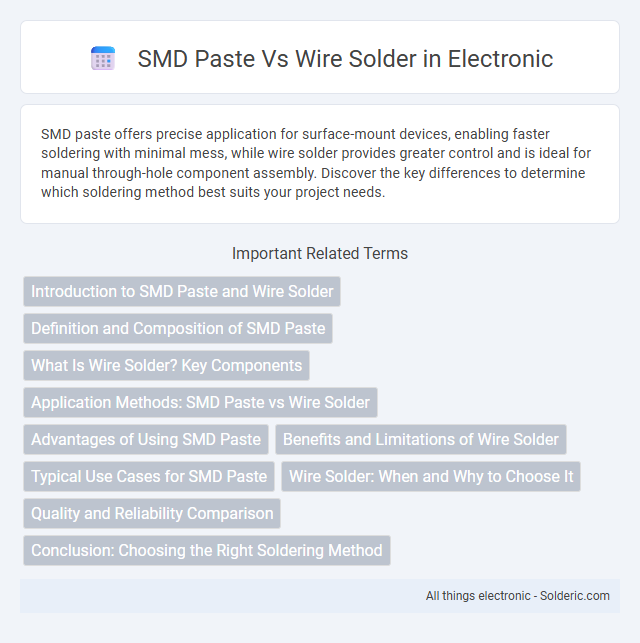SMD paste offers precise application for surface-mount devices, enabling faster soldering with minimal mess, while wire solder provides greater control and is ideal for manual through-hole component assembly. Discover the key differences to determine which soldering method best suits your project needs.
Comparison Table
| Feature | SMD Paste | Wire Solder |
|---|---|---|
| Form | Paste (powder + flux) | Solid wire |
| Application | Surface Mount Device (SMD) PCB assembly | Through-hole and manual soldering |
| Precision | High precision for fine pitch components | Lower precision, best for larger joints |
| Usage method | Stencil printing or syringe dispensing | Hand soldering or soldering iron |
| Flux content | Integrated flux | Core flux inside the wire |
| Reflow compatibility | Designed for reflow soldering | Not suitable for reflow |
| Storage | Requires refrigeration, limited shelf life | Room temperature storage, longer shelf life |
| Cost | Higher cost due to processing and storage | Lower cost, more accessible |
| Common alloys | SnPb, SnAgCu (SAC) | SnPb, SnAgCu, SnCu |
Introduction to SMD Paste and Wire Solder
SMD paste and wire solder serve distinct purposes in electronic assembly; SMD paste is a viscous mixture of solder powder and flux designed for precise application on surface mount device pads before reflow soldering. Wire solder, composed of a metal alloy core with flux, is primarily used for manual or wave soldering to join components on through-hole or surface mount boards. Your choice depends on the specific assembly process, with SMD paste optimizing automated surface mount production and wire solder offering versatility for prototyping and repairs.
Definition and Composition of SMD Paste
SMD paste, also known as solder paste, is a mixture of tiny solder alloy particles suspended in a flux medium, specifically formulated for surface-mount device (SMD) assembly. Unlike wire solder, which is solid and primarily composed of tin and lead or lead-free alloys, SMD paste contains a blend of micron-sized metal powders and organic flux that facilitates solder joint formation during reflow soldering. The flux component in SMD paste promotes wetting and oxide removal, ensuring reliable electrical connections on printed circuit boards (PCBs) during automated soldering processes.
What Is Wire Solder? Key Components
Wire solder is a thin metal alloy rod used for creating electrical connections in electronics and electrical work. Its key components typically include a blend of tin and lead, or in lead-free variants, a combination of tin, silver, and copper, which ensures strong conductivity and reliable bonding. Choosing the right wire solder can improve the quality and durability of Your soldering projects.
Application Methods: SMD Paste vs Wire Solder
SMD paste is applied using a stencil and a squeegee for precise deposition on surface-mount devices, enabling efficient mass production and consistent solder joints. Wire solder requires manual feeding and melting with a soldering iron, making it ideal for through-hole components and repair work but less suited for automated assembly. Your choice between SMD paste and wire solder hinges on the application method, production scale, and component type involved.
Advantages of Using SMD Paste
SMD paste offers superior precision in applying solder to small, complex surface-mount components, reducing the risk of bridging and improving joint reliability. It enables faster reflow soldering processes, enhancing production efficiency and consistency in mass manufacturing. The paste's excellent wetting properties ensure strong mechanical and electrical connections, essential for high-density circuit boards.
Benefits and Limitations of Wire Solder
Wire solder offers advantages such as ease of handling and precise control for manual soldering tasks, making it ideal for repairs and prototyping. Its limitations include lower suitability for high-volume surface mount device (SMD) assembly and potential difficulty in achieving consistent solder joint quality compared to solder paste. Understanding these benefits and limitations helps you choose the appropriate soldering method for your specific electronic assembly needs.
Typical Use Cases for SMD Paste
SMD paste is primarily used for surface mount device (SMD) assembly in automated PCB manufacturing, providing precise solder application for fine-pitch components like resistors, capacitors, and integrated circuits. It enables consistent solder joint quality during reflow soldering, crucial for high-density and miniaturized electronic designs. Wire solder, in contrast, suits through-hole components and manual soldering tasks where bulk solder deposition and rework flexibility are required.
Wire Solder: When and Why to Choose It
Wire solder is ideal for manual soldering tasks requiring strong mechanical bonds or rework on through-hole components due to its ease of control and application. It provides excellent conductivity and reliability for connections exposed to mechanical stress or vibration, making it preferable in environments demanding durability. Choose wire solder when precise, hands-on soldering is necessary, especially in prototyping, repairs, or assembly of larger electronic components.
Quality and Reliability Comparison
SMD paste offers superior consistency and precision in solder joint formation compared to wire solder, resulting in higher overall quality and reduced defects in surface-mount technology assembly. The homogeneous flux distribution and controlled solder volume in SMD paste minimize voids and improve joint reliability under thermal and mechanical stress. Wire solder, while effective for through-hole applications, often leads to inconsistent solder volumes and higher risk of bridging or cold joints in fine-pitch components, impacting long-term device performance.
Conclusion: Choosing the Right Soldering Method
Selecting the right soldering method depends on the specific application and precision required. SMD paste offers superior control for fine-pitch surface mount components and automated assembly, while wire solder is ideal for through-hole joints and quick repairs. Your choice should prioritize efficiency, ease of use, and the type of components involved for optimal solder joint reliability.
SMD paste vs wire solder Infographic

 solderic.com
solderic.com